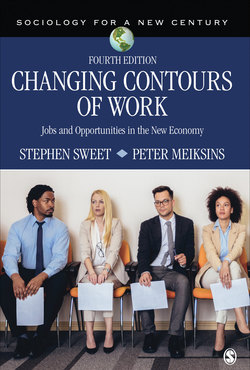Changing Contours of Work

Реклама. ООО «ЛитРес», ИНН: 7719571260.
Оглавление
Stephen Sweet. Changing Contours of Work
Changing Contours of Work
Changing Contours of Work
Contents
About the Authors
Preface to the Fourth Edition
Acknowledgments
Chapter 1 Mapping the Contours of Work
Scenes From the New Economy
Exhibit 1.1 Meg: A Successful Trader Strives to Manage a Demanding Career With a Child Who Has Special Needs
Exhibit 1.2Tammy: A Midcareer Manufacturing Worker Attempts to Salvage a Career and a Community
Exhibit 1.3 Emily: A Contract Worker Navigates Insecure Employment
Exhibit 1.4 Rain: A Chinese Immigrant Finds Work in the American Food Service Industry
Exhibit 1.5 Kavita: A Young Indian Woman Navigates Night Work and Call Center Employment
Exhibit 1.6 Mike: A Disadvantaged Youth Enters a Life of Crime
Culture and Work
Structure and Work
Class Structures
Job Markets and Job Demands
Demography and the New Labor Force
Agency and Careers
Conclusion
Notes
Descriptions of Images and Figures
Chapter 2 New Products, New Ways of Working, and the New Economy
A Postindustrial Society?
The End of Mass Production?
New Skills?
Interpersonal Skills in the Workplace
High-Tech Work
New Cultures of Control?
Technological Change and a Jobless Future?
Rigid Jobs or Flexible Jobs?
The End of Organized Labor?
A New Global Economy?
Conclusion
Notes
Descriptions of Images and Figures
Chapter 3 Economic Inequality, Social Mobility, and the New Economy
Are Economic Divides Narrowing or Widening in the United States?
Are Career Pathways Opening or Closing?
Missing Rungs in the Ladder
Entry Points: Securing the Good Job in Young Adulthood
Exclusion Owing to Criminal Conviction
Is the Global Economy Becoming More Flat or Bumpy?
Conclusion
Notes
Descriptions of Images and Figures
Chapter 4 Whose Jobs Are Secure?
Risk and Work: Historical and Comparative Views
How Insecure Are Workers in the New Economy?
The Costs of Job Loss and Insecurity
Old and New Careers
Risk, Well-Being, and Retirement
The Dawn of the Gig Economy
Conclusion
Notes
Descriptions of Images and Figures
Chapter 5 A Fair Day’s Work?: The Intensity and Scheduling of Jobs in the New Economy
Time, Intensity, and Work
How Much Should We Work? Comparative Frameworks
Why Are Americans Working So Much?
Nonstandard Schedules: Jobs in a 24/7 Economy
How Americans Deal With Overwork
Conclusion
Notes
Descriptions of Images and Figures
Chapter 6 Gender Chasms in the New Economy
When Did Home Work Become Nonwork?
Women’s Participation in the Paid Labor Force in America
Gender Inequalities in Compensation
Socialization, Career Selection, and Career Paths
Interpersonal Discrimination in the Workplace
Structural Dimensions of Gender Discrimination
The Devaluation of “Women’s Work”
Exhibit 6.10 Two Different Job Descriptions: Why Does One Job Pay Less Than the Other? Hand Laborers and Material Movers
Child Care Workers
How Job Designs Discriminate
Strategies to Bridge the Care Gaps: International Comparisons
Conclusion
Notes
Descriptions of Images and Figures
Chapter 7 Race, Ethnicity, and Work: Legacies of the Past, Problems in the Present
Histories of Race, Ethnicity, and Work
African American Exceptionality
The Immigrant Experience
Magnitude of Racial Inequality in the New Economy
Intergenerational Transmission of Resources
Race, Ethnicity, and Economic Capital
Race, Ethnicity, and Human Capital
Race, Ethnicity, and Social Capital
Race, Ethnicity, and Cultural Capital
Geographic Distribution of Race and Work Opportunity
Racial Prejudice and Discrimination
Racialized Jobs
Race, Ethnicity, and Work: Social Policy
Organizational Strategies
Affirmative Action
Immigration Policy
Conclusion
Notes
Descriptions of Images and Figures
Chapter 8 Reshaping the Contours of the New Economy
Opportunity Chasms. Class Chasms
Gender Chasms
Racial and Ethnic Chasms
International Chasms
Agents of Change
Individuals
Activist, Advocacy, and Interest Groups
Unions and Organized Labor
Employers
Government
A Fair Labor Standards Act for the New Economy
Decreasing Inequities in Affluence and Opportunity
International Organizations and International Controls
Conclusion
Notes
Appendix Legislative and Regulatory Timeline of Worker Rights and Protections in the United States
1884
1891
1903
1912
1913
1914
1916
1920
1926
1931
1932
1933
1935
1936
1938
1947
1949
1958
1959
1962
1963
1964
1965
1967
1969
1970
1974
1978
1982
1985
1989
1990
1993
1996
1998
1999
2009
2010
References
Index
Отрывок из книги
Jobs and Opportunity in the New Economy
Peter Meiksins is Professor Emeritus of Sociology at Cleveland State University. He has published widely on the sociology of work, particularly the sociology of technical work and of the professions, in journals such as Work and Occupations; Sociological Quarterly; Work, Employment & Society; Theory and Society; Technology and Culture; and Labor Studies Journal. He has coedited several books on work and labor and is the coauthor of two books, Engineering Labour: Technical Workers in Comparative Perspective and Putting Work in Its Place: A Quiet Revolution. His current research focuses on engineers, the environment and the state, and gender and engineering. He divides his time between Cleveland and Amsterdam. He enjoys travel, running, cooking, and reading.
.....
0 to 4; 4; 3.9; 3.4; 3.2; 3; 2.8
5 to 9; 4.1; 4; 3.7; 3.5; 3; 2.8
.....